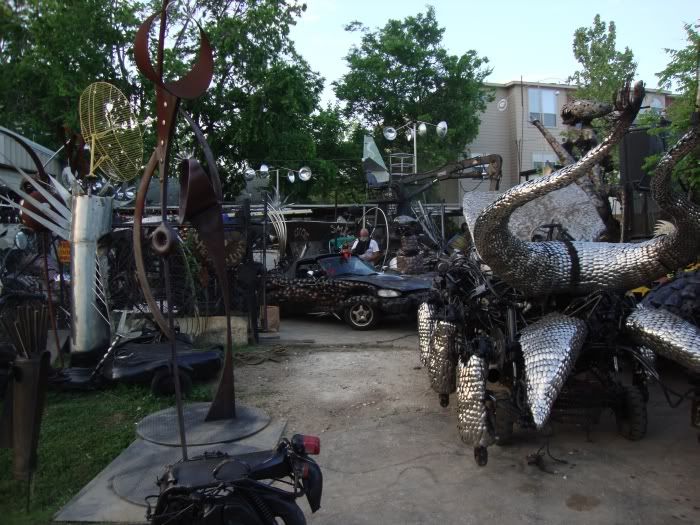[From the Drawn & Quarterly blog] As if that isn't the best news ever, Dan embarks on his tour next week. So new Clowes book and the chance to see him in person? Oh wait, did I mention a slide show, because we just put it together and it is fantastic! What could be better, well if you live in Boston you get to see Ghost World after the event, which Dan will introduce!!!Sigh.
05/03/10 | 7 PM
Washington DC
POLITICS & PROSE
With Dan Kois
05/04/10 | 6 PM
Cambridge
BRATTLE THEATER & HARVARD BOOKSTORE
With Hillary Chute
05/05/10 | 7 PM
NYC THE STRAND
With David Hajdu
05/07/10 | 7 PM
Toronto TCAF & TPL
With Mark Medley
05/08/10-05/09/10
Toronto TCAF & TPL
05/13/10 | 7:30 PM
San Francisco THE BOOKSMITH
With Glen David Gold
05/14/10 | 7:30 PM
Los AngelesSKYLIGHT BOOKS
With Dana Gould
05/16/10 | 7:30 PM
Portland POWELLS
With Greg Netzer, Director of Wordstock
06/03/10 | 7 PM
Oakland DIESEL
With Eli Horowitz
06/12/10 | 7 PM
Chicago QUIMBY'S (signing only)
06/13/10 | TBA
Chicago PRINTERS ROW
With Ray Pride
Wednesday, April 28, 2010
Dan Clowes on Tour (But Not in Houston)
Labels:
comics,
Dan Clowes,
John Porcellino
Notes on Backing Into Forward
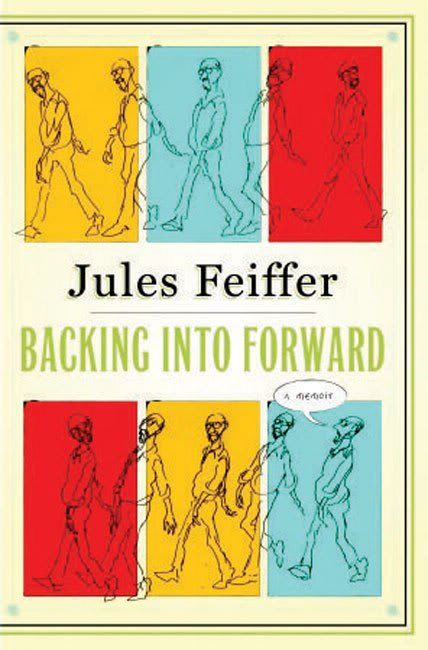
Backing Into Forward by Jules Feiffer
One of my favorite cartoonists is Jules Feiffer. He got his start in the 1950s at the fledgling Village Voice. His work can be related to a lot of cartoonists who were coming up at the time, who he mentions as either as influences or as colleagues. The obvious ones are Saul Steinberg, William Steig and Robert Osborn. He admits that in his first few weeks doing his strip, he imitated them. Then he found his own style.
The style of the day was slick and inked with a brush. It was fairly minimal, but still felt very carefully crafted. Feiffer had drawn quite a feature called Clifford, which appeared in the Spirit newspaper comics insert, that operated within that slick, brush-line minimal style. Early Peanuts strips looked like that, too.
But these other guys were not worrying about slickness. Maybe it had something to do with abstract expressionism. These 1950s era New York City cartoonists couldn't have been unaware of this artistic movement, in which paint was laid down in ways that strongly showed the hand of the artist. Indeed, the work sometimes has the feel of handwriting. (In particular the work of Mark Tobey and Franz Kline, but I think "handwriting" can be applied to almost all of them.) This showed in these new, sophisticated 50s cartoonists. Their work had a hand-writerly quality, and I'd say none more so than Feiffer. His almost scribbly drawings are perfect for showing body language, and its body language that propels his strips. He could not rely on a reader's familiarity with this or that character, because with a few exceptions, he didn't have repeating characters. So he had six images to make you understand the personality and inner-life of his one-off characters. His dialogue was great, witty, and perceptive. But it's body language that gives these characters life.
This memoir is rather scattered. One can tell he wrote it in bits and pieces and then tried to assemble it. It doesn't quite come together. But it is completely entertaining. He writes about his childhood and about his work-life as an adult. He is pretty reticent about his personal life, more and more so as he gets closer to the present.
Feiffer is beloved among certain art comics fans because he came up as a fan of 4-color comics and moved on to create his own highly personal comics for adults. This pathway is pretty common for art cartoonists now. But I get the impression that it was quite bizarre in Feiffer's time. Certainly Saul Steinberg didn't grow up reading Detective Comics. Feiffer was such a super-fan that he ended up working for Will Eisner--he eventually became the writer of The Spirit. He describes writing his first story and realizing, when he was done, that he had written about his old neighborhood in the Bronx.
Feiffer never went to college. He wasn't a beatnik, but he did some beatnik-ish things, like hitchhiking across the country and back. (Hitchhiking was apparently a fad in the early 50s.) He was drafted but managed to avoid being sent to Korea. His experience in the Army lead him to write one of his best stories, Munro, about a little boy who is accidentally drafted. But it wouldn't see publication until after he had established himself at The Village Voice. It was too far out there for publishers in the early 50s.
Feiffer moved to Brooklyn and happened to be neighbors with Norton Juster. They got to be friends, and when Juster wrote a children's book, he asked Feiffer to illustrate it. This ended up being a masterpiece--The Phantom Tollbooth. I read it over and over as a kid, and carefully copied the Feiffer drawings. Even though this book was a great success, Feiffer wouldn't think about doing children's books again for decades--and when he finally did, he was hugely successful at it.
Backing Into Forward paints an interesting picture of the intellectual and artistic milieu of New York City in the 50s and 60s (but one could wish for some juicier stories). Although he is defends his choice to be a cartoonist, he recognizes that a lot of serious people, his readers in fact, don't take it seriously as a means of artistic expression. They see it as less than being a novelist or playwright or painter. I wonder if Feiffer didn't feel the same way, too, just a bit. Because in the end, he tried his hand at more respectable artistic pursuits--writing novels (not notably successful) and then writing plays (pretty successful).
He writes at length about his plays and his career writing them, a period that had a distinct beginning and ending. If you have read The Man in the Ceiling, his first children's novel, you know how he feels about critics. One gets the impression that he blames them for essentially ending his career as a playwright. He writes, "Critics mean little to a play, except life or death."
I thought about this a lot. Don Thompson wrote that in his analysis, critics and reviewers had no effect on the value of visual art. It's been proven that as far as big-budget Hollywood films go, critics have almost no effect. (They can have a great effect on the success of independent or foreign films.) So why should plays be so different?
The answer is obvious when you think about it. With both visual art and movies, you make whatever capital expenditure you're going to make early on, and then you present the work to the public. At that point, you don't have much in the way of ongoing expenses. With a play it's different. I did a very rough free cash flow spreadsheet for a play. I assumed that the investors put in $1 million. The play costs $300,000 per month to stage (salaries, janitorial, lights and heat, insurance, etc.). There are 200 seats and tickets cost $100, so a full house in a month will produce revenue of $600,000. And finally, let's assume the cost of capital is 10%. Let's say that the critic sees the dress rehearsal and has a review out the morning of opening night. Under my scenario, if the monthly drop off rate in ticket sales is 7.1% or higher, the play loses money for the investors (i.e., the net present value is less than zero). At 7.1% decay, it starts losing money on a month-by-month basis by month 9 (at which point the play is either forced to end, or else the investors pony up more money--which do you think will happen?). So if the review can effect that viewership drop-off rate, it can close a play down pretty quick. With a drop off rate of 50%, you break even on expenses in the first month, but can't keep the doors open subsequently. The investors are completely wiped out in that scenario--unless they immediately close the play, in which case they still lose money but minimize their losses. You are an investor, you see how many seats are filled the day the review is printed, and given the free cash flow projection you did, you can very rationally decide to pull the plug right then.
My example is extremely simplistic and makes some assumptions that probably aren't true. But I think the basic theory--that a play costs a lot to perform, which makes it terribly vulnerable to reviews, has some truth. At least as far as the New York commercial theater during Feiffer's heyday.
Losing Feiffer as a playwright was not a tragedy because we gained a superb children's book author/illustrator--not to mention a pretty good memoirist.
Tuesday, April 27, 2010
The Laurel Nakadate Backlash

Laurel Nakadate, still from Beg For Your Life, video, 2006
I thought I was going out on a limb when I panned Laural Nakadate. I mean, it seems like Houston loves her--in the past year, she has had two exhibits here (at Diverse Works and at the Art League). But I feel her work was kind of exploitative, particularly of the lonely old pervy guys with whom she enacts her scenarios. It turns out I'm not the only one who thinks so.
Bless her heart, that Laurel Nakadate just can’t help herself. She’s just cute as a button and old, weird guys flock to her. What’s a girl to do but exploit and mock them for her art? Nakadate does just that in her videos, some of which are on view as a part of the FotoFest exhibition “Medianation” at the Art League, Houston.Good piece.
Am I just imagining this, or has a “Bum Fight” sensibility taken hold of our culture? All sorts of media types and wannabes are mocking and/or exploiting others for entertainment, from Howard Stern to reality TV to YouTube. I see this practice slowly seeping into the artworld and being perceived as “edgy.”
The message for artists seems to be, go ahead, take advantage of the unwitting, the poor, the desperate, the pathetic, the naïve. Hey it’s for YOUR ART! And aren’t you and your art, so much more important than these people? (Kelly Klaasmeyer, Glasstire)
Labels:
Kelly Klaasmeyer,
Laurel Nakadate
Pay Your Income Taxes With Art
You can do this--if you are an artist in Mexico and you pass muster with a government jury. This program has been in place since 1957, when an artist friend of David Siqueiros and Gerardo "Dr. Atl" Murillo was in tax trouble, and the two renowned muralists convinced the government to take work in lieu of taxes. The Mexican government formalized the practice in 1975, and by now has one of the biggest collections in the world.

(Hat tip to Marginal Revolution.)
The government displays these treasures in Mexican museums and government offices and, increasingly, loans them out for special exhibitions around the world. Other works are stored in a huge, climate-controlled warehouse in Mexico City.
Clerks dutifully post each artwork on the tax office website, and the agency hangs them proudly in its own museum in downtown Mexico City. (Visitors to the website can see what each artist has given each year. Click on "Colecciones Pago en Especie" at apartados.hacienda.gob.mx/cultura/index.html). (Chris Hawley, USA Today, 4/16/2010)
The article doesn't say if the government ever sells the pieces. This is a tricky issue. On one hand, the purpose of taxes is to give the government operating funds. Fine art obviously doesn't help there. In fact, in terms of cash flow, a piece of art is costing you money all the time in terms of storage cost (not to mention the cost of capital--after all, the government could sell a piece, invest the money in U.S. Treasuries, and earn a small but safe level of interest. At the very least, that is what they forgo by owning the art.) But if they were to sell pieces, there'd probably be a lot of resistance--especially if they were sold abroad. I'm sure that many Mexicans consider these works part of their national patrimony. But at the same time, Mexico could use the money--maybe to, say, increase the hazard pay of police in Juarez.
Not everyone can pay with art. Participants must register with the Tax Administration Service, Mexico's version of the Internal Revenue Service, by submitting a body of their work to the jury and proving they have shown or sold artworks.
About 700 artists are registered, though not all of them pay with art every year, [program director José] San Cristóbal [Larrea] says.Of course, this means there is an official government body deciding whether or not you are good enough to be a real artist. I know that probably rubs some people wrong, but not me. Art is full of gatekeepers--there is no "pure" or completely just system of finding the best artists. The piece below was paid as taxes in 2008.

Fabian Ugalde, Informative Art, mixed media, 2008
(Hat tip to Marginal Revolution.)
Labels:
Fabian Ugalde,
Mexico
Monday, April 26, 2010
New Review on 29-95 of Material & deStructure at Poissant Gallery
Robert Boyd
I have a new review up at 29-95. Please check it out. It's a review of the group show at Poissant Gallery (which you can see until May 8).
As usual, I have some extra photos from the show. Like this one:

Jeff Forster, Frailty, found object, porcelain, native Houston clay, 2010
Jeff Forster is a ceramicist whose work deals with the natural reality of clay—some of his work involves taking natural clay and firing it and returning it to the environment, “essentially speeding up geologic time.” But for Frailty, made of a wooden box, porcelain and native Houston clay, it’s not geologic time that’s represented but urban time. The best word to describe it would be debris. It looks like the remnant of a long abandoned building, perhaps damaged by a natural disaster, slowly sinking back into a state of nature.

Paul Kittelson, Tombs, contact paper, glass, wood, 2010
This is one you really need to see in person to experience. The effect of the refraction of the light through the glass is really neat. The name "tombs" is perfect for these little pyramids. I imagine a science fiction novel, set in some far distant future where civilization, after reaching almost incomprehensible technological heights, has collapsed. You are with a group of wanderers and you come across these crystal pyramids--mysterious, uneroding, ancient but ageless. (And then Yes starts playing "Starship Troopers" and you wake up to find the joint you were holding has burned a hole through your new velour shirt.)

Marzia Faggin, Abstraction Re-Abstracted, acrylic on canvas, 2010
I wrote about this one in the review, but they didn't run a photo. So if you read the review, here is one of the two Faggin paintings I wrote about.
I have a new review up at 29-95. Please check it out. It's a review of the group show at Poissant Gallery (which you can see until May 8).
As usual, I have some extra photos from the show. Like this one:

Jeff Forster, Frailty, found object, porcelain, native Houston clay, 2010
Jeff Forster is a ceramicist whose work deals with the natural reality of clay—some of his work involves taking natural clay and firing it and returning it to the environment, “essentially speeding up geologic time.” But for Frailty, made of a wooden box, porcelain and native Houston clay, it’s not geologic time that’s represented but urban time. The best word to describe it would be debris. It looks like the remnant of a long abandoned building, perhaps damaged by a natural disaster, slowly sinking back into a state of nature.

Paul Kittelson, Tombs, contact paper, glass, wood, 2010
This is one you really need to see in person to experience. The effect of the refraction of the light through the glass is really neat. The name "tombs" is perfect for these little pyramids. I imagine a science fiction novel, set in some far distant future where civilization, after reaching almost incomprehensible technological heights, has collapsed. You are with a group of wanderers and you come across these crystal pyramids--mysterious, uneroding, ancient but ageless. (And then Yes starts playing "Starship Troopers" and you wake up to find the joint you were holding has burned a hole through your new velour shirt.)

Marzia Faggin, Abstraction Re-Abstracted, acrylic on canvas, 2010
I wrote about this one in the review, but they didn't run a photo. So if you read the review, here is one of the two Faggin paintings I wrote about.
Labels:
installation,
Jeff Forster,
Marzia Faggin,
painting,
Paul Kittelson,
sculpture
New Acquisitions--Chad Hagen, William Powhida, and Ward Sanders
I mentioned a while back that I had bought a William Powhida print through 20x200. This is the one I bought:

William Powhida, Why You Should Buy Art, archival ink print, edition of 500, 14" x 11", 2010
The concept behind 20x200 is to create artworks that are cheap enough for non-wealthy collectors to buy. The add two pieces every week (one photographic, one not). The prices range from $20 to $200. I recently bought two more pieces from 20x200.

Chad Hagen, Nonsensical Infographic No. 3, archival in print, 10" x 8", 2010

Chad Hagen, Nonsensical Infographic No. 4, archival in print, 10" x 8", 2010
I got these because not only are they beautiful to look at, they also deal with one of my favorite subjects--the visual representation of data. Of course, these are ironic because they are visual representations of no data. But let this be a warning. I intend in the near future to write something about data, statistics, and data visualization as art.
Chad Hagen is a designer, the profession that has been most deeply involved with data visualization.
One thing I don't like about the 20x200 pieces is that they aren't signed on the artwork. I was taught that when you do editions, you should sign and number them, usually in pencil, on the front underneath the image. But 20x200 has the artists sign little slips of paper that come with the prints.
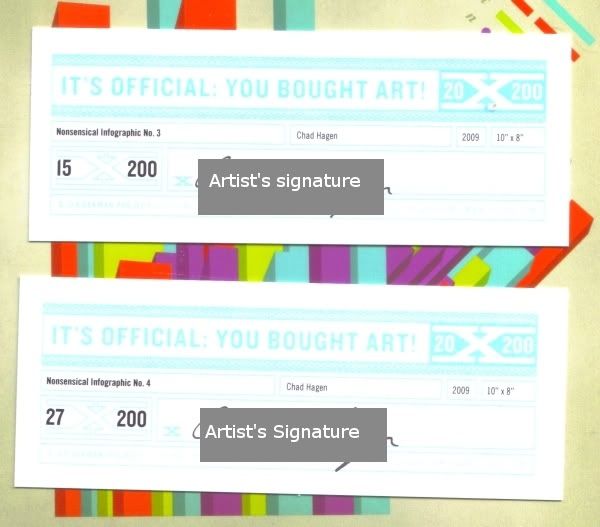
My problem with these is that it separates the signature--which is the thing that authenticates the work--from the physical piece. It also places a burden on the collector. He or she needs to keep track of this little slip of paper from now on.
Anyway, these are my recent budget fine art buys. Small inexpensive limited editions, offered through an internet store, are a great way to get involved with collecting. It's definitely a lot less intimidating than the alternatives. Like going into a gallery and buying a piece. If one is not an experienced buyer from galleries (and I am not), one always wonders what the etiquette is. In almost any other retail establishment, you don't have to worry about this. But art is a luxury item, and buying it seems like it should involve certain rituals and niceties.
Here's what I bought recently at Hooks-Epstein. It's called Zarzuelas and it is by an artist named Ward Sanders.
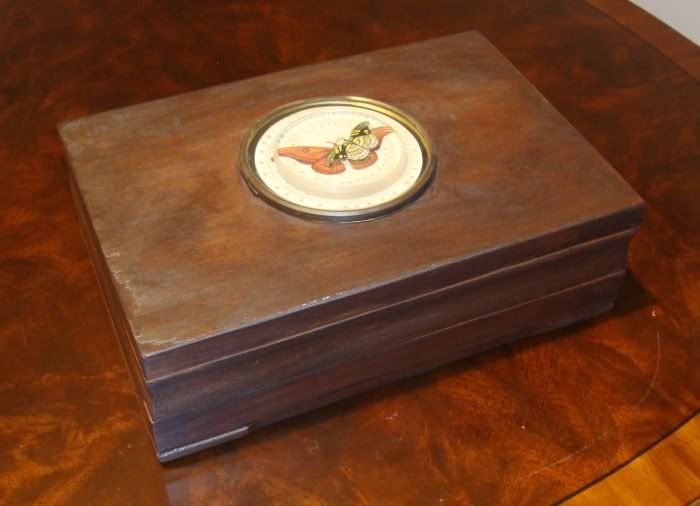
Ward Sanders, Zarzuelas, assemblage, 11" x 16" x 5.5", 2010
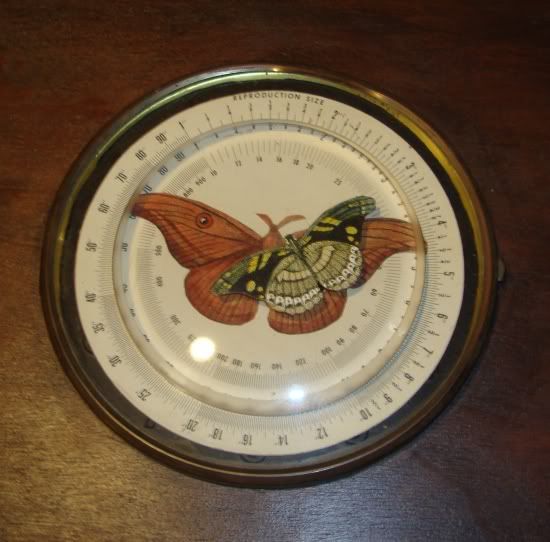
Ward Sanders, Zarzuelas detail, assemblage, 11" x 16" x 5.5", 2010
Sanders' exhibit consisted mostly of wooden boxes with mysterious things in them. The obvious antecedent is Joseph Cornell.
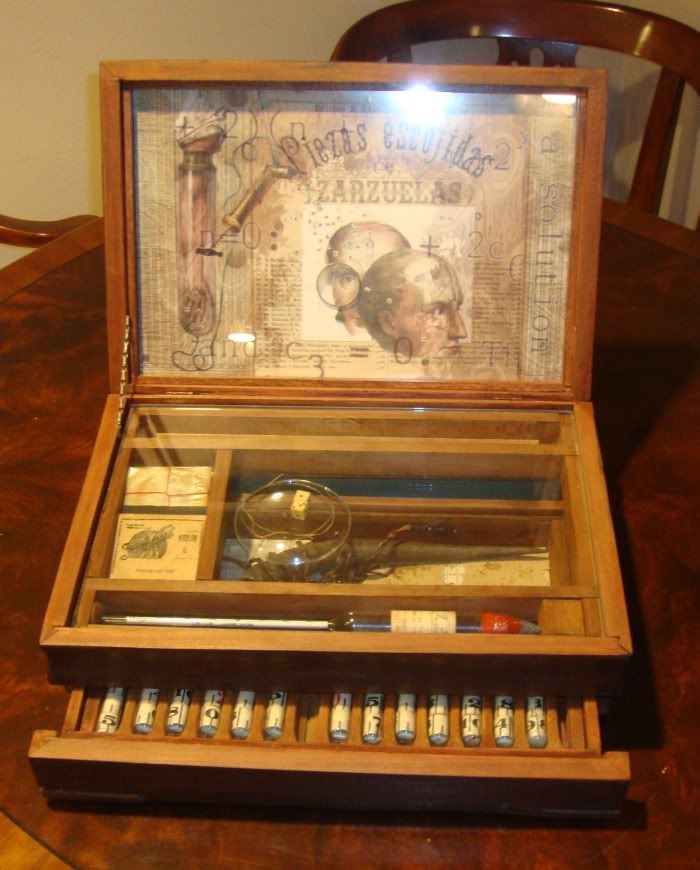
Ward Sanders, Zarzuelas, assemblage, 11" x 16" x 5.5", 2010

Ward Sanders, Zarzuelas detail, assemblage, 11" x 16" x 5.5", 2010
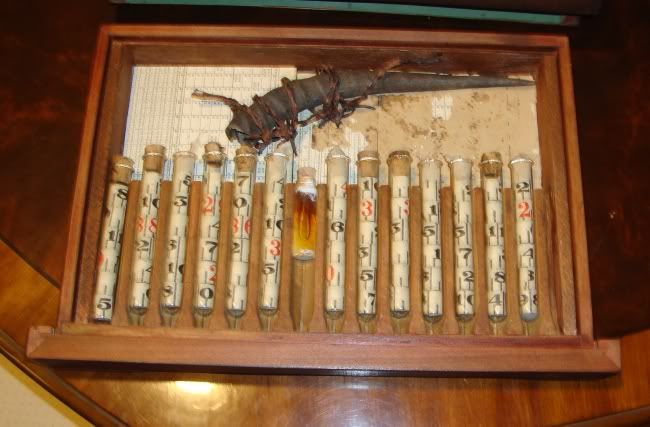
Ward Sanders, Zarzuelas detail, assemblage, 11" x 16" x 5.5", 2010
I had, buying Zarzuelas, a slightly amusing experience. I asked a question about the piece--what was the liquid in the test tube. They shrugged their shoulders--"Eh, I dunno." But once I made my interest in buying clear, they quickly got the artist on the phone! (I'll leave the contents mysterious for you.)
One thing that distinguishes Sanders biographically is that he has no formal art education, as far as I know. He has a BA in biology and did some graduate level work (but I don't know if it was in art or not). These days, when so many artists are credentialed professional (an absurdity when you think about it), it is kind of a novelty to run across one who doesn't have an MFA. In any case, his lack of education hasn't hurt him none. His pieces in this show were beautiful, mysterious, full of hidden antique knowledge. I'm reading Winters Tale by Mark Helprin right now--Sander's assemblages remind me a little bit of Helprin's novel of a fantastic turn of the century New York.

William Powhida, Why You Should Buy Art, archival ink print, edition of 500, 14" x 11", 2010
The concept behind 20x200 is to create artworks that are cheap enough for non-wealthy collectors to buy. The add two pieces every week (one photographic, one not). The prices range from $20 to $200. I recently bought two more pieces from 20x200.

Chad Hagen, Nonsensical Infographic No. 3, archival in print, 10" x 8", 2010

Chad Hagen, Nonsensical Infographic No. 4, archival in print, 10" x 8", 2010
I got these because not only are they beautiful to look at, they also deal with one of my favorite subjects--the visual representation of data. Of course, these are ironic because they are visual representations of no data. But let this be a warning. I intend in the near future to write something about data, statistics, and data visualization as art.
Chad Hagen is a designer, the profession that has been most deeply involved with data visualization.
One thing I don't like about the 20x200 pieces is that they aren't signed on the artwork. I was taught that when you do editions, you should sign and number them, usually in pencil, on the front underneath the image. But 20x200 has the artists sign little slips of paper that come with the prints.

My problem with these is that it separates the signature--which is the thing that authenticates the work--from the physical piece. It also places a burden on the collector. He or she needs to keep track of this little slip of paper from now on.
Anyway, these are my recent budget fine art buys. Small inexpensive limited editions, offered through an internet store, are a great way to get involved with collecting. It's definitely a lot less intimidating than the alternatives. Like going into a gallery and buying a piece. If one is not an experienced buyer from galleries (and I am not), one always wonders what the etiquette is. In almost any other retail establishment, you don't have to worry about this. But art is a luxury item, and buying it seems like it should involve certain rituals and niceties.
Here's what I bought recently at Hooks-Epstein. It's called Zarzuelas and it is by an artist named Ward Sanders.

Ward Sanders, Zarzuelas, assemblage, 11" x 16" x 5.5", 2010

Ward Sanders, Zarzuelas detail, assemblage, 11" x 16" x 5.5", 2010
Sanders' exhibit consisted mostly of wooden boxes with mysterious things in them. The obvious antecedent is Joseph Cornell.

Ward Sanders, Zarzuelas, assemblage, 11" x 16" x 5.5", 2010

Ward Sanders, Zarzuelas detail, assemblage, 11" x 16" x 5.5", 2010

Ward Sanders, Zarzuelas detail, assemblage, 11" x 16" x 5.5", 2010
I had, buying Zarzuelas, a slightly amusing experience. I asked a question about the piece--what was the liquid in the test tube. They shrugged their shoulders--"Eh, I dunno." But once I made my interest in buying clear, they quickly got the artist on the phone! (I'll leave the contents mysterious for you.)
One thing that distinguishes Sanders biographically is that he has no formal art education, as far as I know. He has a BA in biology and did some graduate level work (but I don't know if it was in art or not). These days, when so many artists are credentialed professional (an absurdity when you think about it), it is kind of a novelty to run across one who doesn't have an MFA. In any case, his lack of education hasn't hurt him none. His pieces in this show were beautiful, mysterious, full of hidden antique knowledge. I'm reading Winters Tale by Mark Helprin right now--Sander's assemblages remind me a little bit of Helprin's novel of a fantastic turn of the century New York.
Labels:
art acquired,
assemblage,
Chad Hagen,
infographics,
prints,
Ward Sanders,
William Powhida
Sunday, April 25, 2010
New Acquisitions--Frank Robbins, Chester Gould and Skip Williamson
I have gotten a little behind on my "new acquisitions" posts. I always feel a little reluctant to do them because they feel vainglorious and make me look like the kind of person who brags about his stuff. Which is what I am doing, so I can't dodge that one. One thing I'm trying to do is discuss collecting in a non-rarified way. I am not a rich guy, but I am able to collect. If you like art, you can too.
So I'm going to have two "new acquisitions" posts today. This one will focus on comics art.
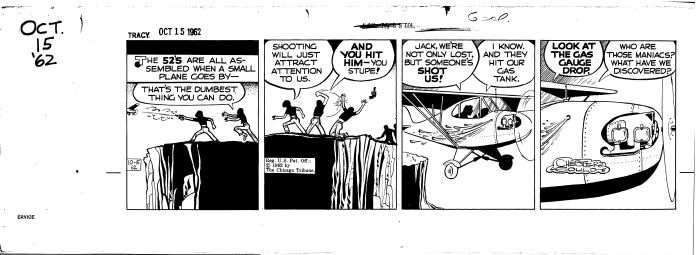
Chester Gould, Dick Tracy, ink on bristol board, October 15, 1962

Chester Gould, Dick Tracy, ink on bristol board, October 18, 1962
I was able to get both of these pretty cheap. I think the reason why is that neither of them showed Dick Tracy or any of his regular characters or his distinctive villains. But Chester Gould's drawing and storytelling are well-represented in these two pieces. We see his typical use of silhouette in the earlier strip. And the airplane sequence--especially with the successive downward sloping black areas--is fantastic. Two relatively minor examples from one of America's greatest artists.
This next one is from the same year, curiously enough. Frank Robbins is a far lesser artist than Gould, but still interesting as a guy who started off as a Caniff imitator and evolved his own unique variation on that style. It's looser than Caniff's, with a lot more crazy anatomy (which gives his characters an unexpected expressiveness).

Frank Robbins, Johnny Hazard, ink on bristol board, August 9, 1961
The last new piece in the collection is far more recent.

Skip Williamson, "Snappy Sammy Smoot, Death Merchant" page 2, ink, halftones, photo-typesetting on illustration board
Some of you may recognize this as a page from a story that I already own another page of. Bought from the same dealer, of course. Maybe I'll eventually get them all. Skip Williamson is an underground cartoonist, one of the originals from the 60s. This piece was done in the 1980s.
So I'm going to have two "new acquisitions" posts today. This one will focus on comics art.

Chester Gould, Dick Tracy, ink on bristol board, October 15, 1962

Chester Gould, Dick Tracy, ink on bristol board, October 18, 1962
I was able to get both of these pretty cheap. I think the reason why is that neither of them showed Dick Tracy or any of his regular characters or his distinctive villains. But Chester Gould's drawing and storytelling are well-represented in these two pieces. We see his typical use of silhouette in the earlier strip. And the airplane sequence--especially with the successive downward sloping black areas--is fantastic. Two relatively minor examples from one of America's greatest artists.
This next one is from the same year, curiously enough. Frank Robbins is a far lesser artist than Gould, but still interesting as a guy who started off as a Caniff imitator and evolved his own unique variation on that style. It's looser than Caniff's, with a lot more crazy anatomy (which gives his characters an unexpected expressiveness).

Frank Robbins, Johnny Hazard, ink on bristol board, August 9, 1961
The last new piece in the collection is far more recent.

Skip Williamson, "Snappy Sammy Smoot, Death Merchant" page 2, ink, halftones, photo-typesetting on illustration board
Some of you may recognize this as a page from a story that I already own another page of. Bought from the same dealer, of course. Maybe I'll eventually get them all. Skip Williamson is an underground cartoonist, one of the originals from the 60s. This piece was done in the 1980s.
Labels:
art acquired,
Chester Gould,
collecting,
comics,
Frank Robbins,
Skip Williamson
Saturday, April 24, 2010
Terra Infirma at Rudolph Blume Fine Art
This is an experiment. I am sitting in the Black Lab just finishing a beef Wellington. I'm typing this on my iPad. I took photos of the show, which i edited with an app called Photogene and then uploaded to Photobucket (which also has an iPad app). On one hand, what is difficult is figuring out how to create a post remotely from the iPad. But that's not all. My additional challenge is to successfully post after drinking a certain number of glasses of beer and wine.
Terra Infirma was a show of three artist at Rudolph Blume Gallery (where I bought my Stephanie Toppin painting last year). The artists were Dixie Friend Gay (she gets my vote for oddest name), Ruben Coy and Scott Winterrowd. Winterrowd's paintings--watercolors of mushroom clouds--seemed less interesting to me than Gay's or Coy's. They also were the odd works out compared to the other two artists, both of whom are nature painters.
We don't think about nature painters very much anymore, and that's too bad. Houstonians are pretty familiar with the work of Melissa Miller, but this work is different. Miller usually features animals--Gay and Coy are all about the flora.

Dixie Friend Gay, Water Plants, acrylic on paper
As it turns out, I am pretty familiar with Gay's work--at least some of it. Two of her paintings hare hung in the dining room at the Jones Graduate School of Business, where I typically spent at least a few minutes of every day while I was a student there. I liked those paintings a lot--what appealed to me especially was the lack of a focal point. They were all-over compositions, not unlike Jackson Pollock, but realistic.
The paintings in this show aren't quite like that. They depict a comprehensible space. There may not be an obvious focal point in these paintings, but the composition of colors is designed in a way that Pollock's paintings (and Gay's JGSB paintings) apparently were not.
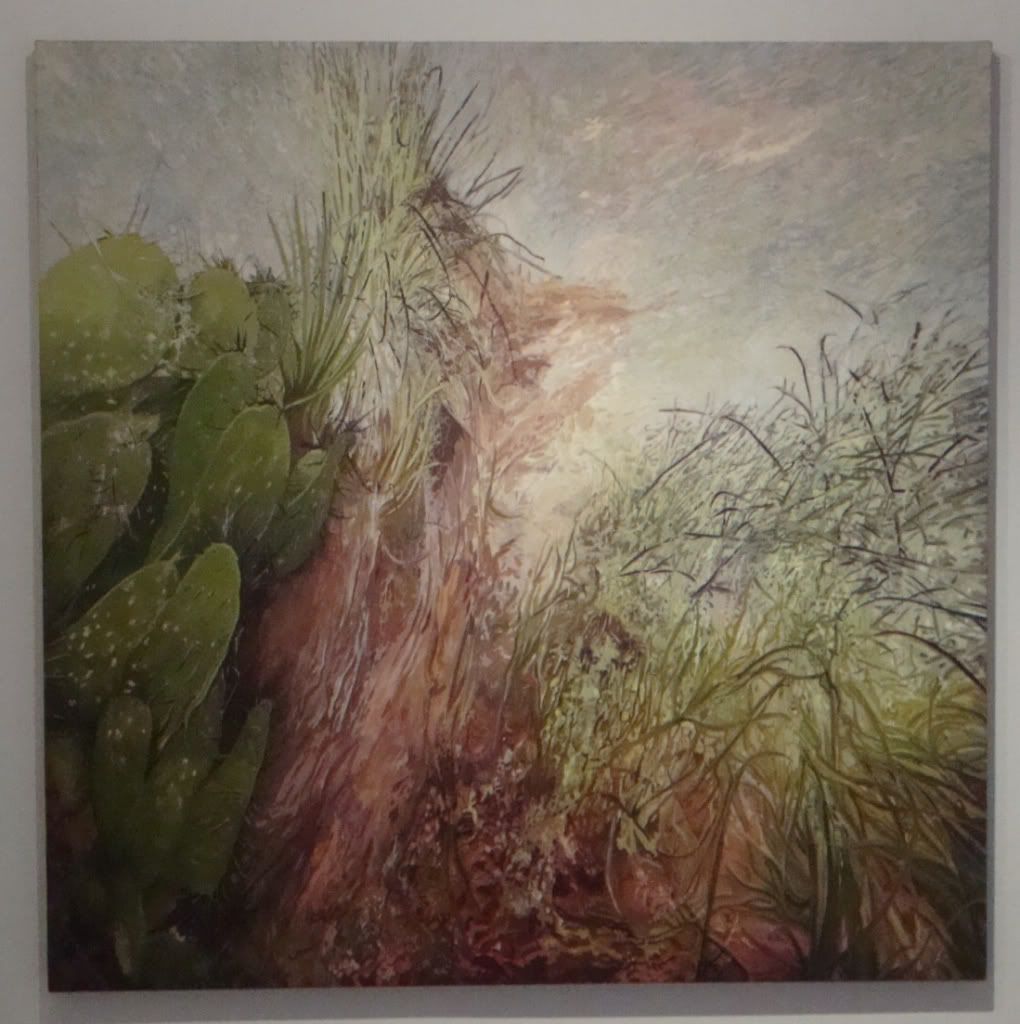
Dixie Friend Gay, Desert, acrylic on canvas
Two of her paintings deserve special mention. They belong together.

Dixie Friend Gay, Bird, acrylic on canvas
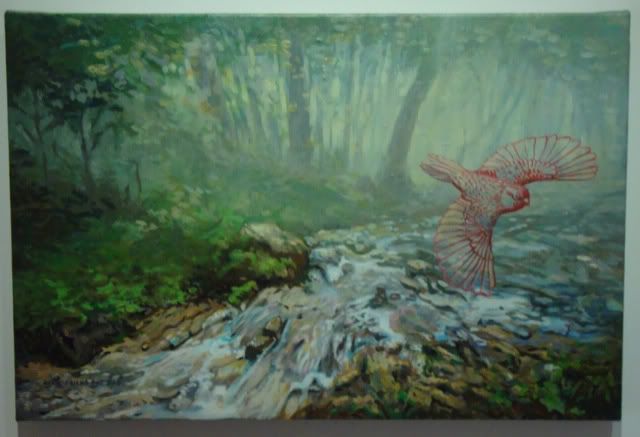
Dixie Friend Gay, Red Bird, acrylic on canvas
I hope that some collector buys both. The bird and its ghostly double are clearly related and should not be separated.
Ruben Coy's paintings of plants are altogether more lush. In fact, the word I would use for them is "pulpy". Indeed, the first thing that came to mind when I looked at his painting was that he should paint the cover for the next edition of One Hundred Years of Solitude. Unlike Friend's paintings, there is a lot of high-contrast between light and dark values. The application of paint is creamy and thick. It has a strong visual impact without having a lingering compositional interest. In short, these paintings feel like illustrations rather than paintings. I don't want to get into an involved discussion of the difference between illustration art and non-illustration art. Everyone has his own definition. I don't consider one superior to another, per se. That said, illustration art is defined by its immediacy. A great painting is one that you can return to again and again. (Some illustration art certainly qualifies in that regard.)
The difference between Coy's art and Friend's art was profound, despite their similar subjects. I don't have the titles, but here are a few examples of Coy's paintings at this show. I think the differences will be obvious.
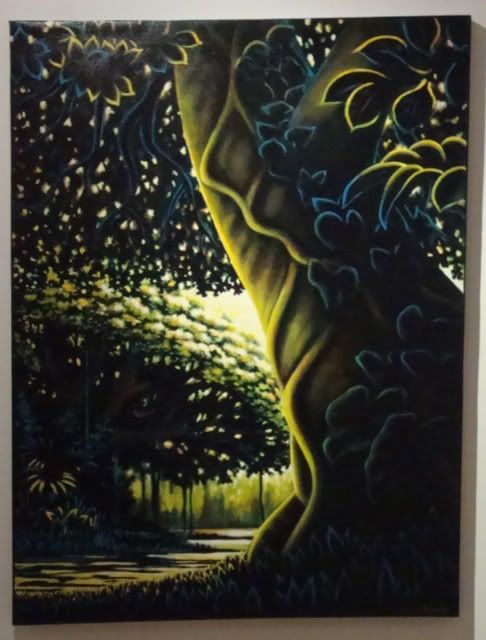
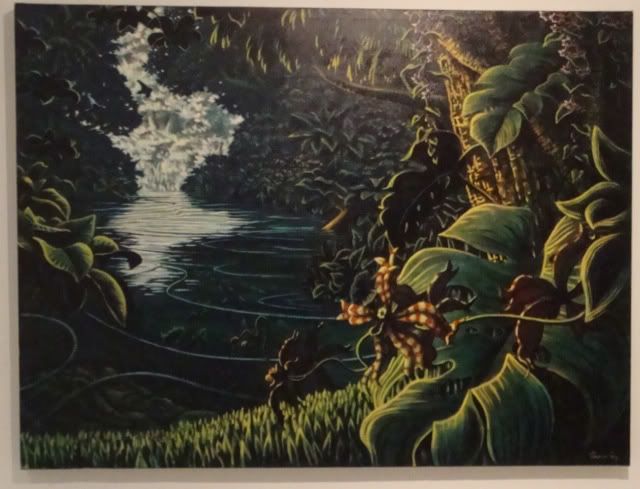

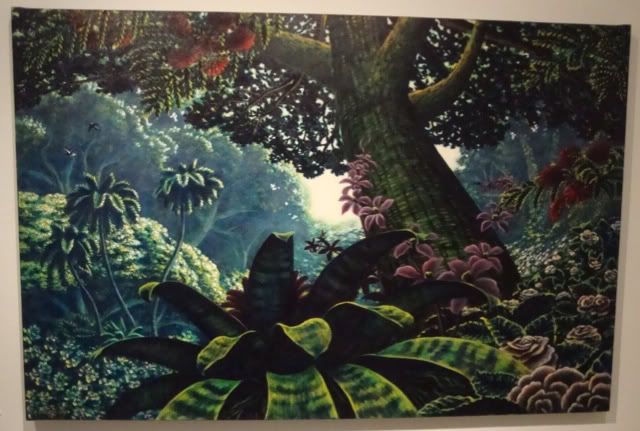
My preference is for Gay, but I can see how people might lean toawards Coy.
(By the way, the experiment was not completely successful. None of the photo apps on the iPad let you scale the image precisely the way you can with IrfanView or almost any other Windows-based image editor. As you can see, some of the images are too wide for the column. I hope this weakness is corrected in the future. An IrfanView app would be welcome! But more importantly, because of the quirky way that Safari works on the iPad, editing a blog post is next to impossible. So--anyone from Google reading? Please make a dedicated iPad Blogger app. Or if Typepad wants to do it, I am willing to switch!)
Terra Infirma was a show of three artist at Rudolph Blume Gallery (where I bought my Stephanie Toppin painting last year). The artists were Dixie Friend Gay (she gets my vote for oddest name), Ruben Coy and Scott Winterrowd. Winterrowd's paintings--watercolors of mushroom clouds--seemed less interesting to me than Gay's or Coy's. They also were the odd works out compared to the other two artists, both of whom are nature painters.
We don't think about nature painters very much anymore, and that's too bad. Houstonians are pretty familiar with the work of Melissa Miller, but this work is different. Miller usually features animals--Gay and Coy are all about the flora.

Dixie Friend Gay, Water Plants, acrylic on paper
As it turns out, I am pretty familiar with Gay's work--at least some of it. Two of her paintings hare hung in the dining room at the Jones Graduate School of Business, where I typically spent at least a few minutes of every day while I was a student there. I liked those paintings a lot--what appealed to me especially was the lack of a focal point. They were all-over compositions, not unlike Jackson Pollock, but realistic.
The paintings in this show aren't quite like that. They depict a comprehensible space. There may not be an obvious focal point in these paintings, but the composition of colors is designed in a way that Pollock's paintings (and Gay's JGSB paintings) apparently were not.

Dixie Friend Gay, Desert, acrylic on canvas
Two of her paintings deserve special mention. They belong together.

Dixie Friend Gay, Bird, acrylic on canvas

Dixie Friend Gay, Red Bird, acrylic on canvas
I hope that some collector buys both. The bird and its ghostly double are clearly related and should not be separated.
Ruben Coy's paintings of plants are altogether more lush. In fact, the word I would use for them is "pulpy". Indeed, the first thing that came to mind when I looked at his painting was that he should paint the cover for the next edition of One Hundred Years of Solitude. Unlike Friend's paintings, there is a lot of high-contrast between light and dark values. The application of paint is creamy and thick. It has a strong visual impact without having a lingering compositional interest. In short, these paintings feel like illustrations rather than paintings. I don't want to get into an involved discussion of the difference between illustration art and non-illustration art. Everyone has his own definition. I don't consider one superior to another, per se. That said, illustration art is defined by its immediacy. A great painting is one that you can return to again and again. (Some illustration art certainly qualifies in that regard.)
The difference between Coy's art and Friend's art was profound, despite their similar subjects. I don't have the titles, but here are a few examples of Coy's paintings at this show. I think the differences will be obvious.




My preference is for Gay, but I can see how people might lean toawards Coy.
(By the way, the experiment was not completely successful. None of the photo apps on the iPad let you scale the image precisely the way you can with IrfanView or almost any other Windows-based image editor. As you can see, some of the images are too wide for the column. I hope this weakness is corrected in the future. An IrfanView app would be welcome! But more importantly, because of the quirky way that Safari works on the iPad, editing a blog post is next to impossible. So--anyone from Google reading? Please make a dedicated iPad Blogger app. Or if Typepad wants to do it, I am willing to switch!)
Labels:
Dixie Friend Gay,
painting,
Ruben Coy
Friday, April 23, 2010
UH at Rice
Robert Boyd
The new show at the Matchbox Gallery at Rice was too big for the tiny space which had housed previous Matchbox exhibits. This show, Joy and Affect, featured 13 artists and ended up sprawled out into the Sewell Hall sunken courtyard. Perhaps to celebrate this new bigness, they projected the words "Matchbox" and "art" on the interior walls.


I was there early. The party hadn't really started. DJs were playing tunes, but the kegs had not been tapped.
Three separate videos were being projected on sheets hung in three big windows.
I accidentally recorded a couple of seconds of video of the courtyard, but I'm glad I did. You can really see how effective the videos were as part if the total environment.
The exhibit was somewhat problematic in one key respect. There was no exhibit list or labels so you could see who was behind the art. I think all the art exhibited was by UH students (!), but there is apparently a Rice student show happening simultaneously. In any case, except in on instance, I don't know who did the work/ If you know the artists (or are one of the artists), please let me know--I want to give credit.

This is obviously a piece by Jorge Galvan. In fact, I think I saw this same piece at Artcrawl last year.I like the elements of it, but compared to his installation at Project Row Houses last year, this piece seems a bit chaotic. It's like he found himself with a good collection of materials but couldn't quite figure out what to make of them.

This little room is the actual Matchbox Gallery. Last night is was inhabited by this giant wrinkly balloon which slowly changed shape as a fan inside it was turned on and off.

Sometimes it hang low to the ground.

Sometimes it was pulled close to the ceiling. Hmmm. In shape and behavior, it reminds me of a certain part of the male anatomy. Whether or not the artist had testicles in mind, the piece has an eerie looming quality.

I wonder if this one is called "Seat of Learning" (or if that is just too corny). It's a well-crafted piece. It allows for multiple and contradictory interpretations. One could say that knowledge and learning, represented by the books, is one of the pillars on which human civilization rests--without it, civilization would collapse. Or you could read it as saying that mere book learning is not practical--a more more practical use for these books is propping up a chair rather than filling someone's brain with "facts." Etc.

This one is both clever and beautiful. In a nice, museum-quality vitrine is a pile of gold and silver doubloons--which, on closer inspection, turn out to be gold and silver Oreos. It's a perfectly lovely bit of surrealist absurdity, made all the more delicious by the museum-like display. (Of course, no museum would simply display a pile of gold coins--it would have each coin separate.)
So, although I was confused about the show, I liked it. The created a neat exhibition environment and put some pretty nice pieces of art in it.
The new show at the Matchbox Gallery at Rice was too big for the tiny space which had housed previous Matchbox exhibits. This show, Joy and Affect, featured 13 artists and ended up sprawled out into the Sewell Hall sunken courtyard. Perhaps to celebrate this new bigness, they projected the words "Matchbox" and "art" on the interior walls.


I was there early. The party hadn't really started. DJs were playing tunes, but the kegs had not been tapped.
Three separate videos were being projected on sheets hung in three big windows.
I accidentally recorded a couple of seconds of video of the courtyard, but I'm glad I did. You can really see how effective the videos were as part if the total environment.
The exhibit was somewhat problematic in one key respect. There was no exhibit list or labels so you could see who was behind the art. I think all the art exhibited was by UH students (!), but there is apparently a Rice student show happening simultaneously. In any case, except in on instance, I don't know who did the work/ If you know the artists (or are one of the artists), please let me know--I want to give credit.

This is obviously a piece by Jorge Galvan. In fact, I think I saw this same piece at Artcrawl last year.I like the elements of it, but compared to his installation at Project Row Houses last year, this piece seems a bit chaotic. It's like he found himself with a good collection of materials but couldn't quite figure out what to make of them.

This little room is the actual Matchbox Gallery. Last night is was inhabited by this giant wrinkly balloon which slowly changed shape as a fan inside it was turned on and off.

Sometimes it hang low to the ground.

Sometimes it was pulled close to the ceiling. Hmmm. In shape and behavior, it reminds me of a certain part of the male anatomy. Whether or not the artist had testicles in mind, the piece has an eerie looming quality.

I wonder if this one is called "Seat of Learning" (or if that is just too corny). It's a well-crafted piece. It allows for multiple and contradictory interpretations. One could say that knowledge and learning, represented by the books, is one of the pillars on which human civilization rests--without it, civilization would collapse. Or you could read it as saying that mere book learning is not practical--a more more practical use for these books is propping up a chair rather than filling someone's brain with "facts." Etc.

This one is both clever and beautiful. In a nice, museum-quality vitrine is a pile of gold and silver doubloons--which, on closer inspection, turn out to be gold and silver Oreos. It's a perfectly lovely bit of surrealist absurdity, made all the more delicious by the museum-like display. (Of course, no museum would simply display a pile of gold coins--it would have each coin separate.)
So, although I was confused about the show, I liked it. The created a neat exhibition environment and put some pretty nice pieces of art in it.
Labels:
Jorge Galvan,
sculpture
Tuesday, April 20, 2010
Hunting Prize Up to Its Old Shenanigans
Last year, you may recall that there were at least two artists who entered work for the Hunting Prize only to have the work disqualified at the last second. Now this wouldn't be such a big deal except for the shitty way Hunting did it. The artists had submitted the work digitally. It made it past the first round of judging. Then the work was mailed (at the artists' expense) to the Hunting Prize--at which point it was disqualified for not being two-dimensional. But there was also a feeling that the subject of the work might have been deemed too controversial. The rules state "Any artwork that includes the use of bodily fluids, degradation of religion or government, and/or depiction of sexual acts or any other medium, presentation or topic objectionable to Hunting PLC will be automatically disqualified.." Last year's disqualified works might have offended some sensitive soul.
So anyway, on to this year. Given what happened last year, I wouldn't be surprised if a bunch of artists didn't submit work. Still, the $50,000 prize is worth trying for.
Now it appears that the same thing that happened to Joan Fabian and "Carlos" has happened to an artist named Devon Grey.
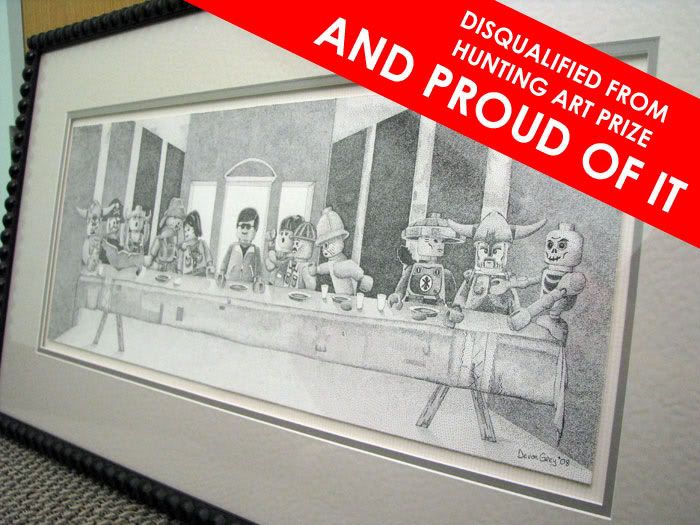
Like Fabian and Carlos last year, Grey was disqualified after he sent his piece in and without explanation.
So why might he have been disqualified? His piece appears to be a drawing, and as far as I can tell from the photo, it is not covered by glass. That's against one of their rules:
Well, we don't know. The Hunting Prize people didn't tell Grey why he had been disqualified. Which is pretty shitty behavior on their part.
Has anyone else out there been disqualified? I'd love to hear from you. Also, if anyone from the Hunting Prize is reading, I would like to hear your side of the story, too. I promise a fair hearing and promise not to divulge anything anyone prefers not to have divulged.
So anyway, on to this year. Given what happened last year, I wouldn't be surprised if a bunch of artists didn't submit work. Still, the $50,000 prize is worth trying for.
Now it appears that the same thing that happened to Joan Fabian and "Carlos" has happened to an artist named Devon Grey.

Like Fabian and Carlos last year, Grey was disqualified after he sent his piece in and without explanation.
So why might he have been disqualified? His piece appears to be a drawing, and as far as I can tell from the photo, it is not covered by glass. That's against one of their rules:
2-D Drawings must be created with traditional drawing medium(s) such as pencil, pen and ink and charcoal or a combination thereof and should be drawn on paper, panel or board and must be framed with glazing (glass or Plexiglas); no loose, exposed or unprotected paper works will be accepted.But then again, it is a religious image--the last supper--populated by Lego men. Could that have been construed as offensive? And if so, why not tell him when he sent the digital image in?
Well, we don't know. The Hunting Prize people didn't tell Grey why he had been disqualified. Which is pretty shitty behavior on their part.
Has anyone else out there been disqualified? I'd love to hear from you. Also, if anyone from the Hunting Prize is reading, I would like to hear your side of the story, too. I promise a fair hearing and promise not to divulge anything anyone prefers not to have divulged.
Labels:
Devon Grey,
Hunting Prize
Legos in the Expanded Field
I don't know anything about James May--he apparently does a show about toys in the U.K. But I loved this Lego house. It's funny that he has two real estate appraisers and an art expert give him values for the house. The real estate appraisers look at it exclusively as a "house" (quite absurd, really) and give ridiculously lowball estimates. The art expert sees it as a sculpture (a rational response, in my view) and gives it a very high estimate. (No one values it on the liquidation value of the Legos themselves, though.)
And here's a video made by one of the youthful volunteers who helped to build the house.
I would like to know who designed the house. Anyone know?
(Hat Tip to Jonathan Chait.)
Labels:
architecture,
sculpture
Monday, April 19, 2010
Scrapdaddy
Last Friday, I was looking for parking for the Poissant Gallery show (great, by the way) and ended up parking next to the Scrapdaddy yard.
The proprietor and creative force, Mark Bradford, was working in the yard, spray painting vehicles. He was getting ready for the Art Car Parade. He invited me to look around. So I literally looked around--here is a 360 view of Scrap Daddy Design:

(Click here for a much larger version.)
Neon Poisoning also has a few photos of the yard, too.
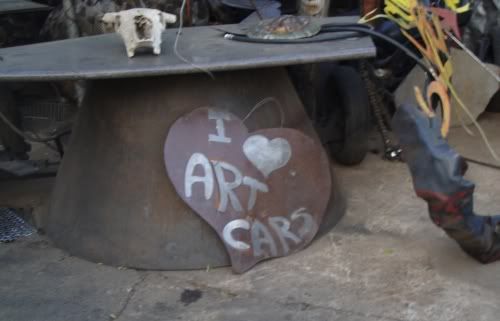
This is getting me in the mood for the parade. I'll be there with various brothers and sisters and nieces and nephews. Looks like Scrapdaddy is going all out this year--should be excellent.
The proprietor and creative force, Mark Bradford, was working in the yard, spray painting vehicles. He was getting ready for the Art Car Parade. He invited me to look around. So I literally looked around--here is a 360 view of Scrap Daddy Design:

(Click here for a much larger version.)
Neon Poisoning also has a few photos of the yard, too.

This is getting me in the mood for the parade. I'll be there with various brothers and sisters and nieces and nephews. Looks like Scrapdaddy is going all out this year--should be excellent.
Labels:
Mark David Bradford,
Scrapdaddy Designs
Saturday, April 17, 2010
Recent Aquisitions--Melissa Thorne and anonymous
Robert Boyd
I went to the Melissa Thorne thing at Optical Project. What she was showing was basically two big curtains and a vinyl record.

So kind of a weird little show... More of a listening party, really.

But it was kind of interesting seeing this colored vinyl record. Such things used to be common. Bill Davenport complained that he had to relearn the now defunct skill of carefully lifting the needle off the record and gently setting down on the record without scratching the record. (People my age not only could perform this delicate operation easily, but we could do it while completely stoned.)
So partly out of vinyl nostalgia, and partly because it was a limited edition, I bought a copy of the record.

Then, in a consumerist frenzy, I also bought this:

What is it? This detail explains all:

I went to the Melissa Thorne thing at Optical Project. What she was showing was basically two big curtains and a vinyl record.

So kind of a weird little show... More of a listening party, really.

But it was kind of interesting seeing this colored vinyl record. Such things used to be common. Bill Davenport complained that he had to relearn the now defunct skill of carefully lifting the needle off the record and gently setting down on the record without scratching the record. (People my age not only could perform this delicate operation easily, but we could do it while completely stoned.)
So partly out of vinyl nostalgia, and partly because it was a limited edition, I bought a copy of the record.

Then, in a consumerist frenzy, I also bought this:

What is it? This detail explains all:

Labels:
art acquired,
Melissa Thorne
Friday, April 16, 2010
Every Painting in the Museum of Modern Art
This video is quite amazing.
But what is really amazing is that the photographer was able to photograph inside the museum! They never let your do this in Houston museums. And I understand the reasoning--they don't want people's flashes to harm delicate paintings and drawings, or distract other patrons. (They also probably want you to buy their catalogs, too.)
At first, I assumed the photographer here was snapping photos on the sly (as I have done many, many times). But as you watch the video, that doesn't seem to be the case--he or she captures several other people photographing the pictures! Does MOMA actually let you photograph paintings inside the museum?
But what is really amazing is that the photographer was able to photograph inside the museum! They never let your do this in Houston museums. And I understand the reasoning--they don't want people's flashes to harm delicate paintings and drawings, or distract other patrons. (They also probably want you to buy their catalogs, too.)
At first, I assumed the photographer here was snapping photos on the sly (as I have done many, many times). But as you watch the video, that doesn't seem to be the case--he or she captures several other people photographing the pictures! Does MOMA actually let you photograph paintings inside the museum?
Labels:
museums
New Acquisitions--Two Drawings by Brad Foster
So I mentioned that I had spoken with some of the exhibitors at the Bayou City Art Festival. One of the guys I spoke with was Brad Foster. I was walking by his booth and saw his large, pen-and-ink drawings. Something about the way they were shaded struck me as familiar. Then it hit me--this was Brad Foster the minicomics artist from the 1980s! It was a totally unexpected place to find him.
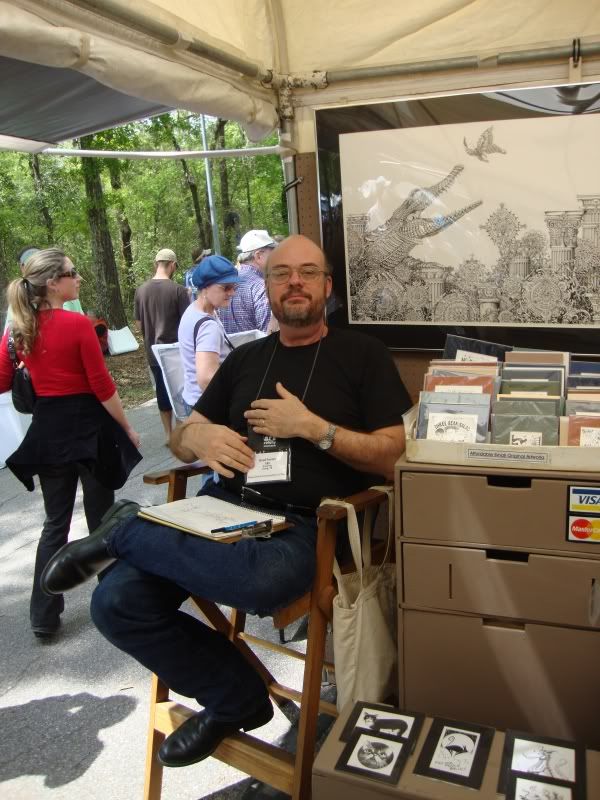
As you can see from the piece to Foster's right in this photo, the artwork Foster was displaying was anything but "mini." But it retained a relationship with his minicomics art by virtue of it being black and white, highly detailed, and stippled. You can see a lot of his work on his website, Jabberwocky Graphix. Now it turns out in the pre-internet of the 80s, I ordered minis from Jabberwocky (or else from some other mini-distributor who was carrying this stuff), including all the issues of Our Story Thus Far, a giant "jam" mini with more than 80 artists adding to the story, bit by bit. (These are still available from Foster.)
Also on his site, you will see his schedule of appearances. He goes to a lot science fiction cons and one anime con (no comics cons, weirdly enough), but mostly he goes to juried art festivals like the Bayou City Art Festival. Now the key word here is "juried." From the way that Foster (and some of the other artists I spoke to) described it, the jury is judging you on your art, but also on your ability to put together a decent booth. These booths are fancy, and I presume getting one together is expensive. Foster mainly goes to juried festivals that are with driving distance of the Dallas/Fort Worth area, but other artists seem to go all around the country.
I had been to "art" festivals up in Seattle before, but I have to say that they seemed more like "craft" festivals. (Back then, it was really popular for exhibitors to make cheesy sculptures out of Mount St. Helens volcanic ash, for some reason.) But as I said, this festival--even though it included a lot of "craft" items (like the marbled tie and hand-carved wooden toys I bought), it was mostly about people working in artforms that have since the Renaissance been classed as high art--painting, drawing, sculpture--and related artforms like printmaking.
Who is on the jury for these things? I dunno (but have asked). How do they pick stuff? How do artists get hooked into this network? It seems that these festivals form an art promotion and marketing apparatus that is fairly distinct from the gallery system (although I am sure there is some overlap). The Festivals have their own gatekeepers (the juries) and their own economies. And, perhaps most important, their own aesthetics. If you were a sociologist writings about the socio-economics of art in America, you simply would have to discuss the festivals. I'd be extremely interested in knowing how much revenue was generated in those three days from art sales.
The weird thing about Foster is that he comes to the Festivals--a kind of alternative art world--from another alternative world, the world of minicomics. I've written about minicomics before on this blog. And in the 90s, I wrote a column for The Comics Journal called "Minimalism." Minicomics were and still are important places for cartoonists to develop their work. But in the 80s, the culture took on a life of its own, where the minicomic format was the goal. There was a non-commercial ideology at work (it didn't have the overt anti-capitalism of other non-commercial art movements, but it did share a certain suspicion of and contempt for larger, for profit operations). The godfather of this movement was an old hippie from Berkeley named Clay Geerdes. He had come out of the world of underground/alternative journalism and somehow hooked up with some young cartoonists who showed uplate for the underground comix party (which, by the late '70s, was pretty dead). Geerdes wrote up a manifesto in 1983 and started publishing his Comix Wave and Comix World series and acting as a central clearing house, connecting artists all around the country to each other. (Another big catalyst was the publication of Factsheet Five starting in 1982.)
Amazingly enough, Foster had some of his minicomics art there. So I bought some.
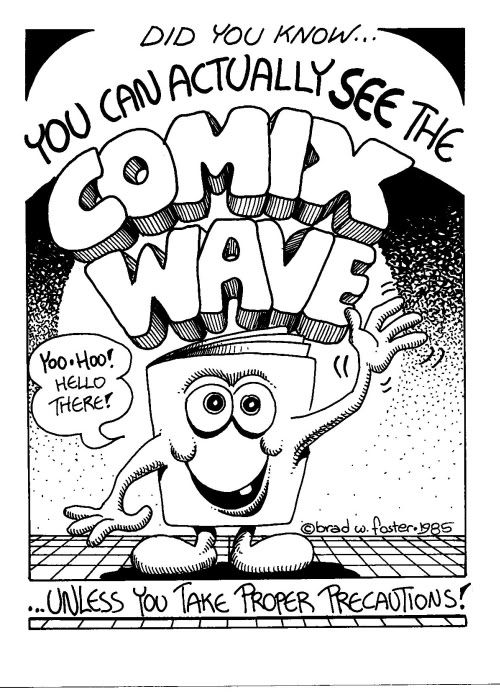
Brad Foster, Comix Wave cover, ink on paper, 1985
This is a cover he did for Clay Geerdes' Comix Wave (obviously). I thought having it would be having a little piece of minicomics history.
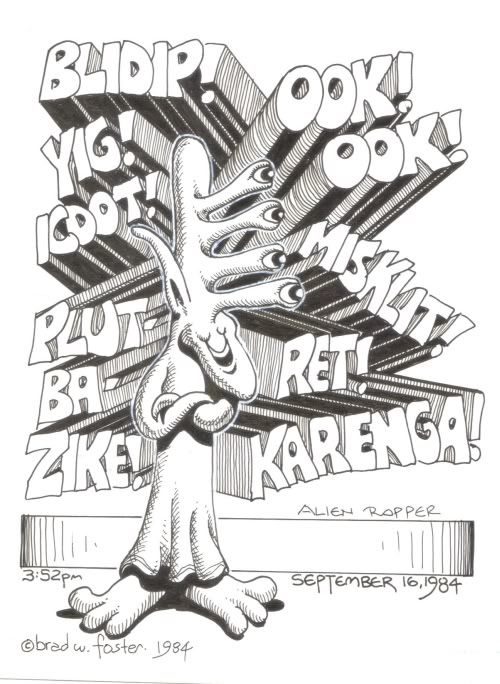
Brad Foster, Alien Rapper, ink on paper, 1985
Foster was astonished to have a customer who knew minicomics. I was astonished to see him in this setting--but delighted--to see him in this setting.
If you want to know more about the history of minicomics, I suggest picking up a copy of Newave!, the huge (892 pages) yet tiny (5" x 6 1/4") anthology of the best minicomics from the 80s. Foster has a lot of work there.
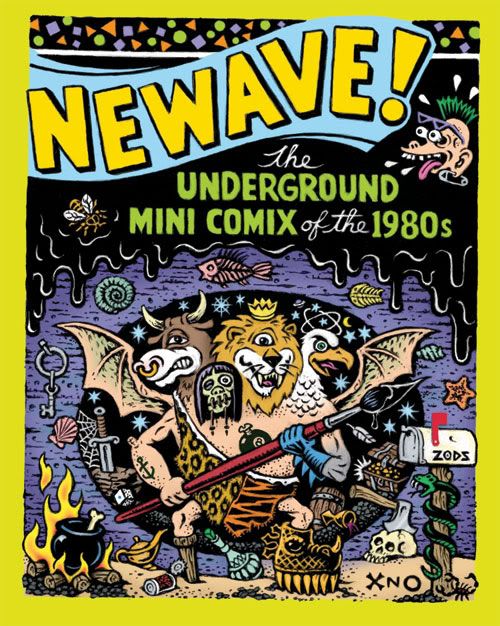
Of course, also check out Foster's website and I'd also recommend taking a look at the Poopsheet Foundation.

As you can see from the piece to Foster's right in this photo, the artwork Foster was displaying was anything but "mini." But it retained a relationship with his minicomics art by virtue of it being black and white, highly detailed, and stippled. You can see a lot of his work on his website, Jabberwocky Graphix. Now it turns out in the pre-internet of the 80s, I ordered minis from Jabberwocky (or else from some other mini-distributor who was carrying this stuff), including all the issues of Our Story Thus Far, a giant "jam" mini with more than 80 artists adding to the story, bit by bit. (These are still available from Foster.)
Also on his site, you will see his schedule of appearances. He goes to a lot science fiction cons and one anime con (no comics cons, weirdly enough), but mostly he goes to juried art festivals like the Bayou City Art Festival. Now the key word here is "juried." From the way that Foster (and some of the other artists I spoke to) described it, the jury is judging you on your art, but also on your ability to put together a decent booth. These booths are fancy, and I presume getting one together is expensive. Foster mainly goes to juried festivals that are with driving distance of the Dallas/Fort Worth area, but other artists seem to go all around the country.
I had been to "art" festivals up in Seattle before, but I have to say that they seemed more like "craft" festivals. (Back then, it was really popular for exhibitors to make cheesy sculptures out of Mount St. Helens volcanic ash, for some reason.) But as I said, this festival--even though it included a lot of "craft" items (like the marbled tie and hand-carved wooden toys I bought), it was mostly about people working in artforms that have since the Renaissance been classed as high art--painting, drawing, sculpture--and related artforms like printmaking.
Who is on the jury for these things? I dunno (but have asked). How do they pick stuff? How do artists get hooked into this network? It seems that these festivals form an art promotion and marketing apparatus that is fairly distinct from the gallery system (although I am sure there is some overlap). The Festivals have their own gatekeepers (the juries) and their own economies. And, perhaps most important, their own aesthetics. If you were a sociologist writings about the socio-economics of art in America, you simply would have to discuss the festivals. I'd be extremely interested in knowing how much revenue was generated in those three days from art sales.
The weird thing about Foster is that he comes to the Festivals--a kind of alternative art world--from another alternative world, the world of minicomics. I've written about minicomics before on this blog. And in the 90s, I wrote a column for The Comics Journal called "Minimalism." Minicomics were and still are important places for cartoonists to develop their work. But in the 80s, the culture took on a life of its own, where the minicomic format was the goal. There was a non-commercial ideology at work (it didn't have the overt anti-capitalism of other non-commercial art movements, but it did share a certain suspicion of and contempt for larger, for profit operations). The godfather of this movement was an old hippie from Berkeley named Clay Geerdes. He had come out of the world of underground/alternative journalism and somehow hooked up with some young cartoonists who showed uplate for the underground comix party (which, by the late '70s, was pretty dead). Geerdes wrote up a manifesto in 1983 and started publishing his Comix Wave and Comix World series and acting as a central clearing house, connecting artists all around the country to each other. (Another big catalyst was the publication of Factsheet Five starting in 1982.)
Amazingly enough, Foster had some of his minicomics art there. So I bought some.

Brad Foster, Comix Wave cover, ink on paper, 1985
This is a cover he did for Clay Geerdes' Comix Wave (obviously). I thought having it would be having a little piece of minicomics history.

Brad Foster, Alien Rapper, ink on paper, 1985
Foster was astonished to have a customer who knew minicomics. I was astonished to see him in this setting--but delighted--to see him in this setting.
If you want to know more about the history of minicomics, I suggest picking up a copy of Newave!, the huge (892 pages) yet tiny (5" x 6 1/4") anthology of the best minicomics from the 80s. Foster has a lot of work there.

Of course, also check out Foster's website and I'd also recommend taking a look at the Poopsheet Foundation.
Labels:
art acquired,
Brad Foster,
comics
Wednesday, April 14, 2010
The Fall Bayou City Art Festival
 This one will be in October and held downtown. Houston artists--maybe you never thought of displaying your art in a small tent of your own, next to dozens of other artists and craftsmen. Perhaps you think your art won't "fit in." You might be right, but who knows? It's juried and a lot of people apply. I would strongly recommend having a mixture of more expensive pieces and cheaper pieces (perhaps prints of some kind).
This one will be in October and held downtown. Houston artists--maybe you never thought of displaying your art in a small tent of your own, next to dozens of other artists and craftsmen. Perhaps you think your art won't "fit in." You might be right, but who knows? It's juried and a lot of people apply. I would strongly recommend having a mixture of more expensive pieces and cheaper pieces (perhaps prints of some kind).Here's the info.
I, for one, think it would be very cool if an artist whose work was a little more cutting edge were in the show. At the very least, it would be an interesting experiment. The deadline to enter is April 30.
Labels:
Life's Rich Pageant
Subscribe to:
Posts (Atom)


